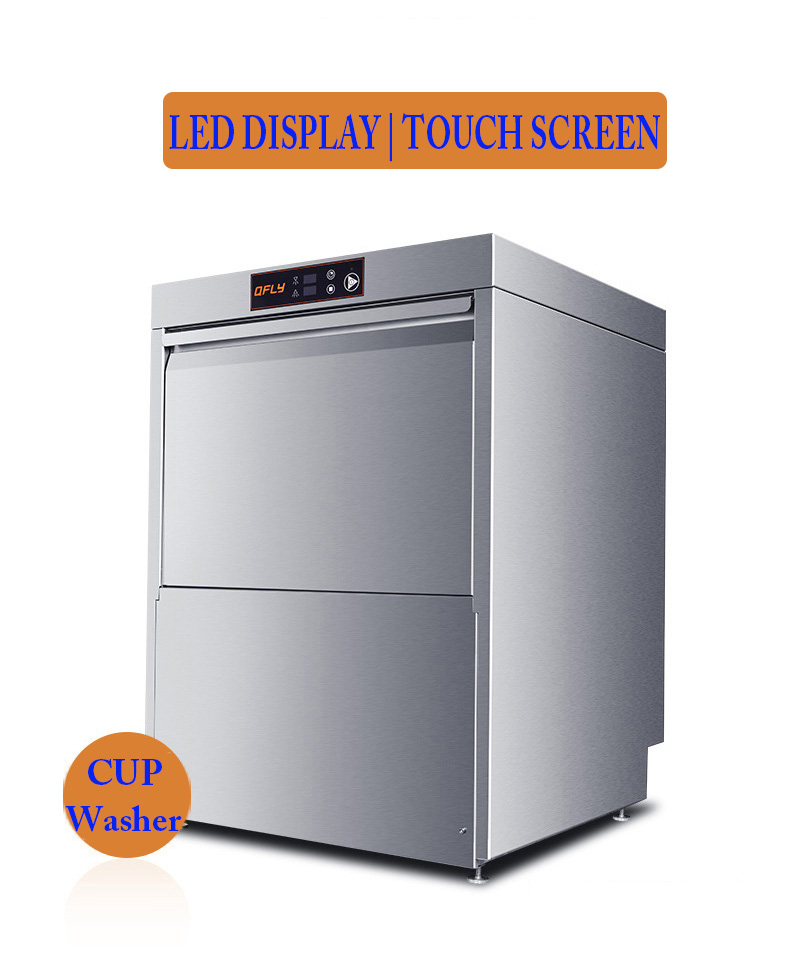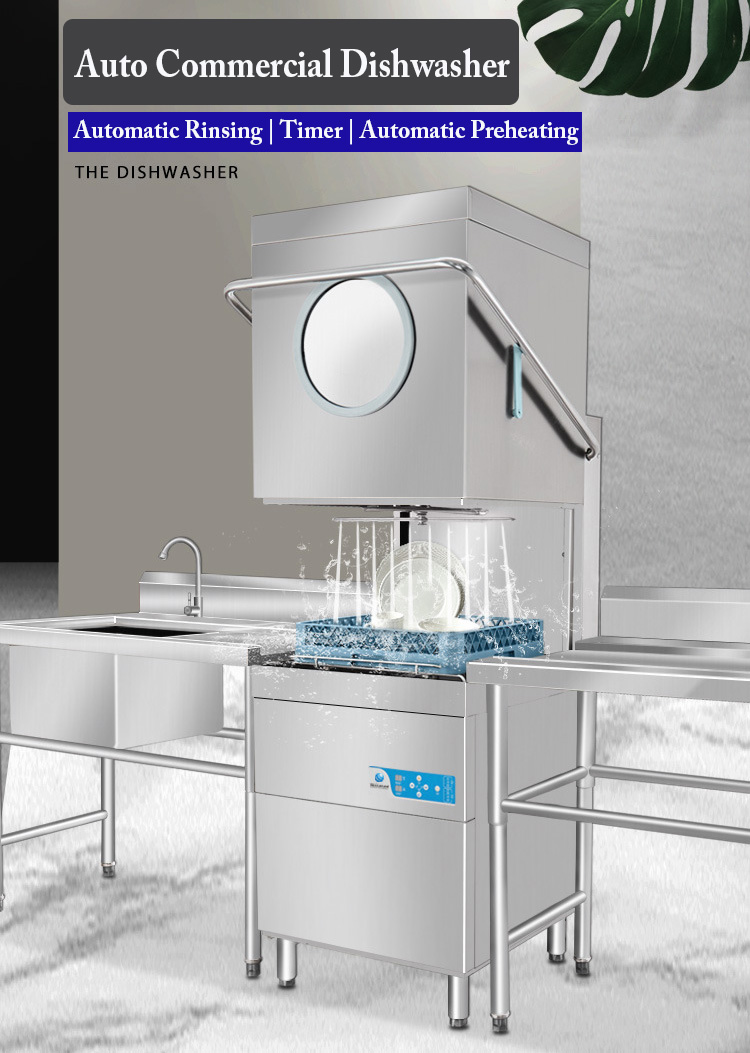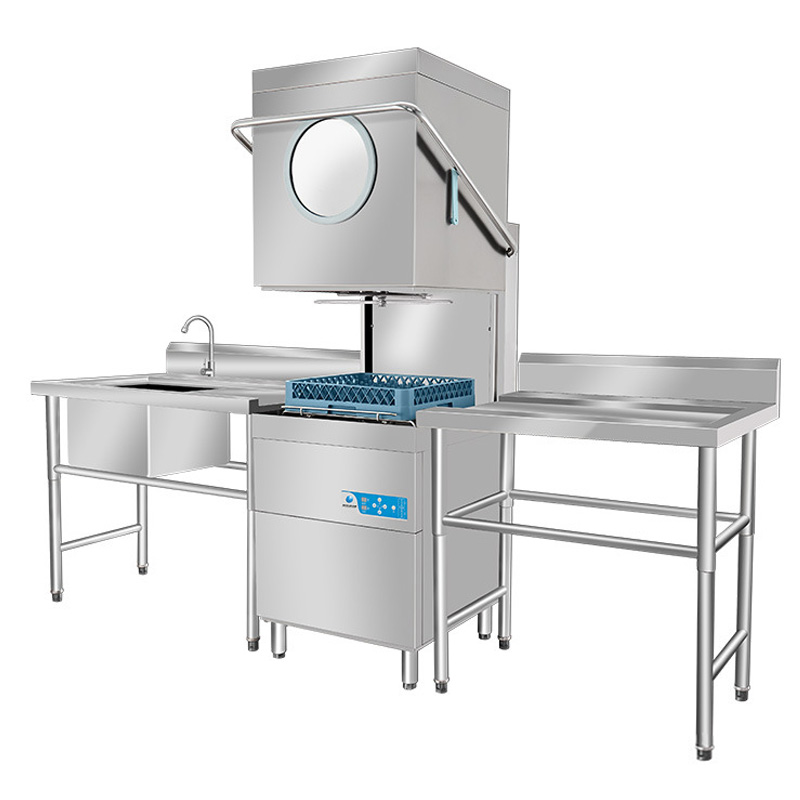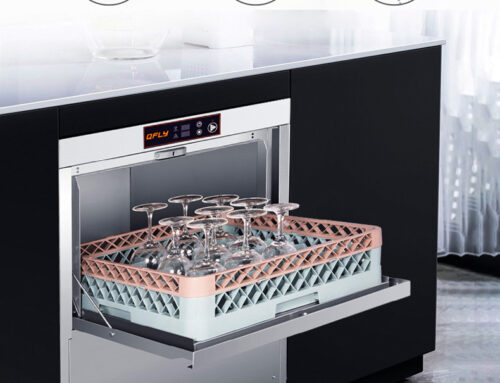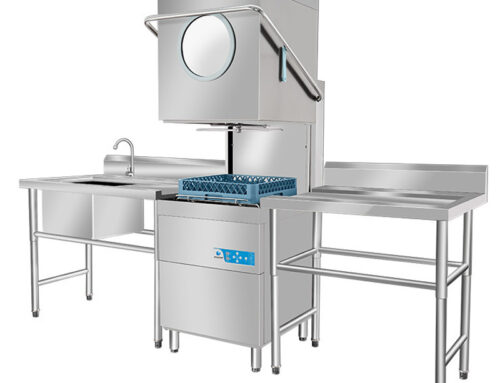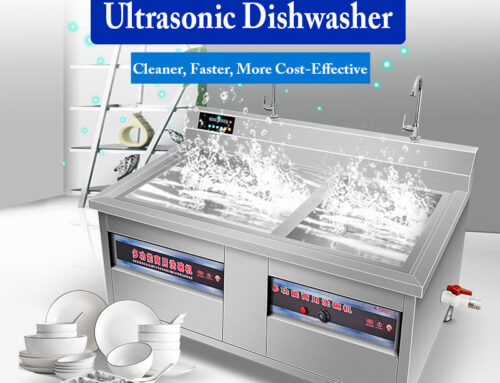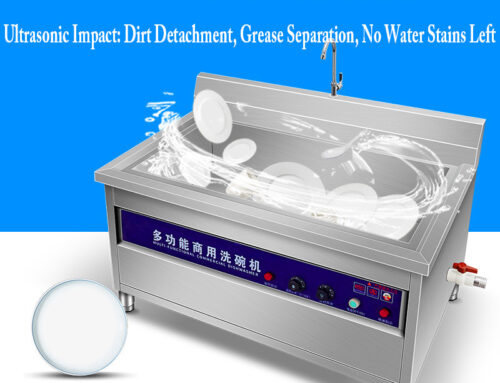Space & Utility Requirements for Stainless Steel Commercial Dishwasher Installation
Installing a stainless steel commercial dishwasher isn’t just about placing the unit in your kitchen—it requires careful planning around space, water lines, drains, and electrical connections. The wrong setup can lead to poor performance, frequent breakdowns, or even code violations. At AT Cooker, we’ve installed hundreds of our stainless steel commercial dishwasher models (like the ZFGT-A series) in restaurants, hotels, and bars worldwide, so we know exactly what’s needed for a smooth, compliant installation. In this guide, we’ll break down every space and utility requirement you need to consider, with specific insights from our product specs to help you prepare your kitchen.
1. A Dedicated Water Supply Line (3/4-Inch to 1-Inch Diameter) with Shut-Off Valve Is Mandatory for Stainless Steel Commercial Dishwashers
Every stainless steel commercial dishwasher needs a dedicated water supply line to ensure consistent pressure and flow—shared lines with other commercial kitchen equipments (like sinks or steamers) can cause pressure drops, leading to incomplete cleaning. The line diameter depends on the machine’s water usage: most under-counter and floor models (including our AT Cooker ZFGT-A-2D and ZFGT-A 90S) require a 3/4-inch line, while high-capacity conveyor models may need a 1-inch line.
AT Cooker Specs to Note: Our ZFGT series stainless steel commercial dishwasher models use 0.66 gallons (2.5L) of water per rack. To support this flow without pressure loss, we recommend a 3/4-inch PEX or copper supply line. A shut-off valve is non-negotiable—it lets you cut water to the machine for maintenance (like cleaning filters or replacing spray arms) without shutting down your entire kitchen’s water supply.
Local plumbing codes often mandate that the water supply line includes a backflow preventer—a device that stops wastewater from flowing back into the clean water supply. This is critical for food safety, as stainless steel commercial dishwasher wastewater may contain food particles or detergent residue. The International Plumbing Code (IPC) provides detailed guidelines on backflow prevention for commercial kitchen equipment.
2. A Separately Vented Floor Drain with an Air Gap Prevents Backflow for Stainless Steel Commercial Dishwashers
Wastewater from your stainless steel commercial dishwasher needs a dedicated floor drain—one that’s not shared with other equipment—to avoid clogs and backflow. The drain must be properly vented (per IPC standards) to release air pressure and ensure smooth water flow, and it must include an air gap: a physical separation between the dishwasher’s drain line and the floor drain that stops contaminated water from siphoning back into the machine.
For AT Cooker models like the ZFGT-A 4D (7KW floor stainless steel commercial dishwasher), we recommend a floor drain with a minimum 2-inch diameter to handle the machine’s wastewater volume (up to 27L sink capacity). The air gap should be at least 1 inch above the drain’s flood level—this is a non-negotiable requirement for passing health inspections, as noted by the U.S. Food and Drug Administration (FDA).
Note: If your kitchen’s existing drain is too small or lacks an air gap, you’ll need to upgrade it before installing your stainless steel commercial dishwasher. A plumber can typically make these adjustments in 1-2 days, but it’s important to budget for this cost (usually $300-$500) upfront.
3. Electrical Requirements: 120V for Small Undercounter Stainless Steel Commercial Dishwashers, 208-240V for Larger Models
Electrical needs vary widely among stainless steel commercial dishwasher models, and using the wrong voltage can damage the machine or create a fire hazard. Smaller under-counter models (like our ZFGT-A-2D) often use 120V single-phase power for light-duty use, while larger floor or conveyor models require 208-240V three-phase power to support their higher wattage (7KW to 9KW for AT Cooker’s ZFGT series).
It’s critical to verify your kitchen’s electrical capacity before purchasing a stainless steel commercial dishwasher. For example, a 9KW model like the ZFGT-A 90S draws more current than a standard 15A circuit can handle—you’ll need a dedicated 30A circuit breaker. AT Cooker provides a detailed electrical spec sheet for every model to help your electrician plan the installation, and we recommend having an electrician inspect your setup before delivery to avoid delays.
4. High-Temperature Stainless Steel Commercial Dishwashers May Need an External Booster Heater (Extra Space & Utilities)
High-temperature stainless steel commercial dishwasher models (like all AT Cooker units) require final rinse temperatures of 180°F (82°C) to meet health codes. While many modern models (including our ZFGT-A 90S) have built-in booster heaters, some older or smaller units may need an external booster heater—adding extra space and utility requirements.
An external booster heater typically needs:
- Space: A 24x24x30-inch area near the dishwasher (it can’t be too far, as heat loss occurs in long water lines).
- Electrical: A dedicated 208-240V circuit (2KW to 3KW, depending on the heater size).
- Water: A separate 3/4-inch supply line (connected to the same water source as the dishwasher).
AT Cooker Advantage: Our ZFGT series stainless steel commercial dishwasher models include integrated booster heaters—no external unit needed! For example, the ZFGT-A 90S has a 65-degree rise booster heater that quickly raises water from 30°C to 95°C, saving you space and eliminating the need for extra utility connections. This is a major benefit for small kitchens where commercial dishwasher size and layout are tight.
5. Standard Clearance Space Around Stainless Steel Commercial Dishwashers Ensures Ventilation & Service Access
Your stainless steel commercial dishwasher needs more space than just its physical dimensions—clearance around the unit is essential for ventilation (to prevent overheating), service access (for repairs), and safe operation. The exact clearance depends on the model type:
- Undercounter models (e.g., ZFGT-A-2D): 2 inches of clearance on the sides and back for ventilation; no top clearance needed (since they fit under counters).
- Floor models (e.g., ZFGT-A 4D, ZFGT-A 90S): 4 inches of clearance on all sides (sides, back, top) to allow air flow and easy access to components like spray arms and filters.
- Conveyor models: 6 inches of clearance on all sides, plus extra space at the inlet/outlet for rack loading/unloading.
To put this in perspective, let’s use the commercial dishwasher size of our ZFGT-A 4D: its physical dimensions are 780×810×1500 mm (W×D×H). With 4 inches (101.6 mm) of clearance on all sides, you’ll need a total space of ~980×1010×1700 mm. This is a key consideration when planning your kitchen layout—skimping on clearance can lead to overheating (which reduces efficiency) or expensive service calls (if technicians can’t access parts easily).
6. The Installation Floor Must Be Level & Support the Weight of a Fully Operational Stainless Steel Commercial Dishwasher
Stainless steel commercial dishwasher models are heavy—even empty. Our ZFGT-A 90S weighs 98 KG (216 lbs) empty, and when full of water and racks, it can weigh over 150 KG (330 lbs). The installation floor must be level (within 1/4 inch per 10 feet) and strong enough to support this weight without cracking or shifting.
Concrete floors are ideal for stainless steel commercial dishwasher installation—they can support up to 100 lbs per square foot, which is more than enough for even large models. If your kitchen has a wood floor, you’ll need to reinforce it with floor joists or a steel plate (a job for a structural engineer or contractor) to avoid damage. The Construction Canada handbook recommends a minimum floor load capacity of 50 lbs per square foot for commercial kitchen equipment.
Note: A sloped floor can cause water to pool inside the dishwasher, leading to rust (even on stainless steel) or uneven cleaning. Use a level tool to check the floor before installation—if it’s sloped, a contractor can level it with a self-leveling concrete mix.
7. Water Pressure Must Be 20-60 PSI for Proper Stainless Steel Commercial Dishwasher Operation
Water pressure is a critical but often overlooked requirement for stainless steel commercial dishwasher performance. Too low (below 20 PSI) and the spray arms won’t deliver enough pressure to clean dishes; too high (above 60 PSI) and you risk damaging valves or causing leaks.
AT Cooker tests all our stainless steel commercial dishwasher models at 40 PSI (the industry standard) to ensure optimal cleaning. If your kitchen’s water pressure is outside the 20-60 PSI range, you’ll need to install a pressure regulator:
- Low pressure (below 20 PSI): A booster pump (installed on the water supply line) can increase pressure to the required level.
- High pressure (above 60 PSI): A pressure-reducing valve will lower pressure to a safe range.
You can check your water pressure with a simple gauge (available at hardware stores for $20-$30). Attach it to a nearby sink faucet—if the reading is outside 20-60 PSI, schedule a plumber to install a regulator before your stainless steel commercial dishwasher arrives.
8. Amperage Requirements: 15-20A for Small Stainless Steel Commercial Dishwashers, 30-50A for Large Models
Amperage (current) is closely tied to voltage and wattage—higher wattage stainless steel commercial dishwasher models draw more amps. Using a circuit with insufficient amperage can trip breakers or damage the machine’s electrical components. Here’s a breakdown of typical amperage needs:
- Small under-counter models (8.6KW, 120V): 15-20A dedicated circuit.
- Mid-sized floor models (7KW, 380V): 25-30A dedicated circuit.
- Large floor models (9KW, 380V): 30-40A dedicated circuit.
- Conveyor models (12KW+, 480V): 40-50A dedicated circuit.
Our ZFGT-A 90S (9KW, 380V) stainless steel commercial dishwasher requires a 35A dedicated circuit. This means the circuit breaker must be rated for 35A, and the wiring must be 10-gauge (the minimum gauge for 35A). Your electrician can confirm your kitchen’s wiring capacity—if it’s too small, they’ll need to run new 10-gauge wire (a cost of ~$200-$300 for a 20-foot run).
9. A Grease Trap in the Drain Line Complies with Codes for High-Volume Stainless Steel Commercial Dishwasher Use
Most local plumbing codes require a grease trap in the drain line of stainless steel commercial dishwasher models used in high-volume operations (like restaurants or hotels). A grease trap captures fat, oil, and grease (FOG) from wastewater before it enters the municipal sewer system—preventing clogs and environmental damage.
The size of the grease trap depends on your stainless steel commercial dishwasher’s water usage:
- Under-counter models (0.66 gallons/rack): 50-gallon grease trap.
- Floor models (0.66 gallons/rack, 60 racks/hour): 100-gallon grease trap.
- Conveyor models (1 gallon/rack, 100 racks/hour): 200-gallon grease trap.
The Water Environment Federation (WEF) provides guidelines on grease trap sizing and maintenance. For AT Cooker customers, we recommend installing the grease trap within 5 feet of the dishwasher’s drain outlet to minimize FOG buildup in the line. Grease traps need to be cleaned every 1-3 months (depending on use)—this is a recurring maintenance cost to factor into your budget ($100-$200 per cleaning).
10. Ambient Air Temperature & Ventilation Affect Stainless Steel Commercial Dishwasher Performance
The area where you install your stainless steel commercial dishwasher must have proper ventilation and a consistent ambient temperature (between 50°F and 95°F / 10°C and 35°C). Extreme temperatures or poor ventilation can cause:
- Overheating: If the room is too hot (above 95°F), the dishwasher’s cooling fans can’t keep components cool, leading to shutdowns.
- Freezing: If the room is too cold (below 50°F), water lines can freeze, damaging valves or the pump.
- Moisture buildup: Poor ventilation leads to excess moisture, which can cause rust on non-stainless steel parts or mold growth.
For best results, install your stainless steel commercial dishwasher near an exhaust fan or in a room with cross-ventilation. Avoid placing it next to heat sources like kitchen cooking equipment (grills, ovens) or in unheated areas (like garages) in cold climates. Our ZFGT series has built-in temperature sensors that shut down the machine if it overheats, but preventing extreme temperatures is always better than relying on safety features.
11. Hard Water May Require a Water Softener for Stainless Steel Commercial Dishwashers
Hard water (water with high mineral content, like calcium and magnesium) can cause scale buildup in your stainless steel commercial dishwasher—on heating elements, spray nozzles, and interior surfaces. Scale reduces efficiency (heating elements have to work harder to heat water) and can lead to costly repairs (clogged spray nozzles or damaged valves).
AT Cooker Tip: Our ZFGT-A 4D stainless steel commercial dishwasher includes a delime cycle to remove light scale, but this isn’t a substitute for a water softener in hard water areas. If your water has more than 7 grains per gallon (GPG) of minerals (check with your local water utility), install a commercial water softener.
A commercial water softener for stainless steel commercial dishwasher use typically needs:
- Space: A 30x30x48-inch area near the water supply line.
- Electrical: A 120V, 15A outlet (for the softener’s control panel).
- Maintenance: Monthly salt refills (cost of ~$10-$15 per month).
12. Electrical Connections Must Comply with National & Local Codes for Stainless Steel Commercial Dishwashers
Every stainless steel commercial dishwasher’s electrical connection must comply with the National Electrical Code (NEC) and local codes. These codes cover everything from wire gauge to grounding, and violations can result in fines or failed inspections. Key requirements include:
- Dedicated circuit: No sharing the circuit with other equipment (even small appliances like toasters).
- Grounding: The dishwasher must be properly grounded to prevent electric shock—this means a 3-wire (or 4-wire for three-phase) connection with a ground wire.
- Weatherproofing: If the dishwasher is installed in a damp area (like a dishroom), the outlet must be GFCI-protected (ground fault circuit interrupter) to prevent shocks from water contact.
AT Cooker provides a code compliance checklist for every stainless steel commercial dishwasher model to help your electrician ensure compliance. We also recommend scheduling a final inspection with your local building department after installation—this gives you peace of mind that the setup is safe and code-compliant.
13. Sufficient Overhead Clearance Is Critical for Rack Loading in Door-Style Stainless Steel Commercial Dishwashers
Door-style stainless steel commercial dishwasher models (like our ZFGT-A 90S) require overhead clearance to open the door and load/unload racks. The exact clearance depends on the door’s swing:
- Vertical-lift doors: 36-48 inches of overhead clearance (the door lifts straight up).
- Side-swing doors: 24-30 inches of clearance to the side (the door swings open horizontally).
Our ZFGT-A 90S has a side-swing door that requires 28 inches of clearance to the right (when facing the machine). If your kitchen has low ceilings or overhead cabinets, a vertical-lift door model may not be feasible—opt for a side-swing or under-counter model instead. Measuring overhead clearance before purchase is key to avoiding installation delays.
14. Drain Line Must Have a Minimum Fall of 1/4 Inch Per Foot for Stainless Steel Commercial Dishwashers
Gravity is what moves wastewater from your stainless steel commercial dishwasher to the floor drain—so the drain line must have a minimum slope (fall) of 1/4 inch per foot. This means for every foot of drain line length, it must drop 1/4 inch. A slope that’s too shallow can cause standing water in the line, leading to clogs, odors, or backflow.
For example, if your stainless steel commercial dishwasher is 10 feet away from the floor drain, the drain line must drop at least 2.5 inches (10 feet x 0.25 inches/foot) from the machine to the drain. A plumber can calculate the required slope and adjust the line during installation—this is a small detail that makes a big difference in long-term performance.
Conclusion: Prepare Your Kitchen for a Stainless Steel Commercial Dishwasher Installation
Installing a stainless steel commercial dishwasher requires careful planning around space, water, drain, and electrical needs—but with the right preparation, it’s a smooth process. By following the requirements outlined here (and using AT Cooker’s model-specific specs), you can ensure your dishwasher operates efficiently, complies with codes, and lasts for years.
At AT Cooker, we’re here to help every step of the way. We provide detailed installation guides, spec sheets, and even virtual site inspections to help you plan your stainless steel commercial dishwasher setup. Our ZFGT series models are designed with installation in mind—compact sizes, integrated utilities (like booster heaters), and durable stainless steel construction make them a top choice for commercial kitchen equipments buyers worldwide.
Ready to install your stainless steel commercial dishwasher? Contact us today to get a custom installation plan for your kitchen. With our 20 years of experience in industrial kitchen equipment, we’ll make sure your new dishwasher is set up for success.
